奥黛丽赫本全英文介绍 Audrey-Hephurn
英文版介绍奥黛丽.赫本
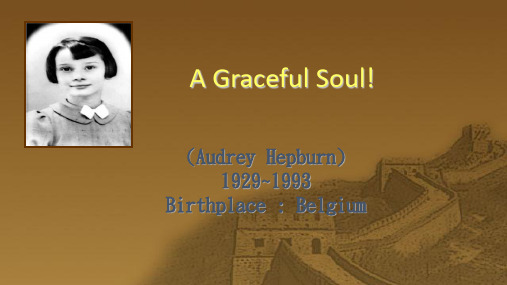
In Somalia
Although modest about her acting ability,
Hepburn remains one of the world's most famous actresses of all time, remembered as a film and fashion icon of the twentieth century.
A Graceful Soul!
(Audrey Hepburn) 1929~1993
Birthplace : Belgium
• Living in the Netherlands
• When comes The Second World War: The Dutch was occupied by Nazi, it is said that her mother is with Jewish ancestry.
The definition of beautiful
Audrey Hepburn said, “It is not about the superficial, it is spiritual.
It is care and love others and passion.”
• The family property was confiscated and her uncle was executed.
• So, Audrey and her mother lived in poverty.
She has acted in many movies: Breakfast at Tiffany's
• In 1999,she elected to be the 3rd most famous actress in the world by American Film Institute.
Audrey Hepburn奥黛丽.赫本生平精品英文介绍(非翻译器翻译)
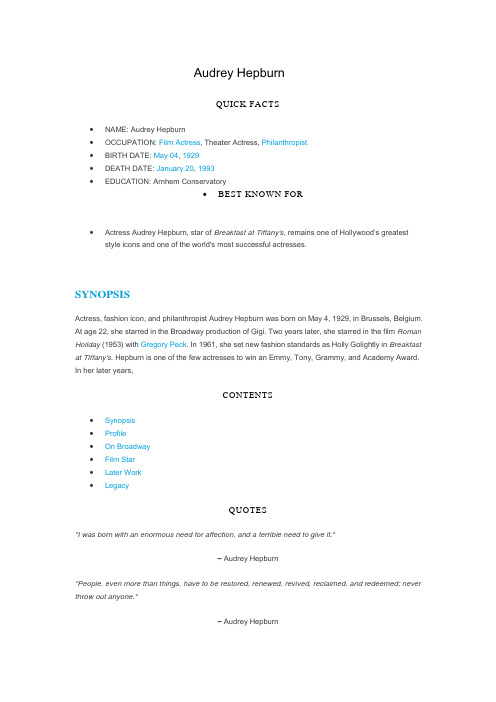
Audrey HepburnQUICK FACTS∙NAME: Audrey Hepburn∙OCCUPATION: Film Actress, Theater Actress, Philanthropist∙BIRTH DATE: May 04, 1929∙DEATH DATE: January 20, 1993∙EDUCATION: Arnhem Conservatory∙BEST KNOWN FOR∙Actress Audrey Hepburn, star of Breakfast at Tiffany's, remains one of Hollywood's greatest style icons and one of the world's most successful actresses.SYNOPSISActress, fashion icon, and philanthropist Audrey Hepburn was born on May 4, 1929, in Brussels, Belgium. At age 22, she starred in the Broadway production of Gigi. Two years later, she starred in the film Roman Holiday (1953) with Gregory Peck. In 1961, she set new fashion standards as Holly Golightly in Breakfast at Tiffany's. Hepburn is one of the few actresses to win an Emmy, Tony, Grammy, and Academy Award. In her later years,CONTENTS∙Synopsis∙Profile∙On Broadway∙Film Star∙Later Work∙LegacyQUOTES"I was born with an enormous need for affection, and a terrible need to give it."– Audrey Hepburn"People, even more than things, have to be restored, renewed, revived, reclaimed, and redeemed; never throw out anyone."– Audrey Hepburn"Remember, if you ever need a helping hand, it's at the end of your arm, as you get older, remember you have another hand: The first is to help yourself, the second is to help others."– Audrey Hepburn"I depend upon Givenchy as American women depend upon their psychiatrist."– Audrey Hepburnacting took a back seat to her work on behalf of children.PROFILEActress, philanthropist. Born on May 4, 1929, in Brussels, Belgium. A talented performer, Audrey Hepburn was known for her beauty, elegance, and grace. Often imitated, she remains one of Hollywood's greatest style icons. A native of Brussels, Hepburn spent part of her youth in England at a boarding school there. During much of World War II, she studied at the Arnhem Conservatory in The Netherlands. After the Nazis invaded the country, Hepburn and her mother struggled to survive. She reportedly helped the resistance movement by delivering messages, according to an article in The New York Times.After the war, Hepburn continued to pursue an interest in dance. She studied ballet in Amsterdam and later in London. In 1948, Hepburn made her stage debut as a chorus girl in the musical High Button Shoes in London. More small parts on the British stage followed. She was a chorus girl in Sauce Tartare (1949), but was moved to a featured player in Sauce Piquante (1950).That same year, Hepburn made her feature film debut in 1951's One Wild Oat in an uncredited role. She went on to parts in such films as Young Wives' Tales (1951) and The Lavender Hill Mob (1951) starring Alec Guiness. Her next project on the New York stage introduced her to American audiences.ON BROADWAYAt the age of 22, Audrey Hepburn went to New York to star in the Broadway production of Gigi, based on the book by the French writer Colette. Set in Paris around 1900, the comedy focuses on the title character, a young teenage girl on the brink of adulthood. Her relatives try to teach her ways of being a courtesan, to enjoy the benefits of being with a wealthy man without having to marry. They try to get a friend of the family, Gaston, to become her patron, but the young couple has other ideas.Only a few weeks after the play premiered, news reports indicated that Hepburn was being wooed by Hollywood. Only two years later, she took the world by storm in the film Roman Holiday (1953) with Gregory Peck. Audiences and critics alike were wowed by her portrayal of Princess Ann, the royal who escapes the constrictions of her title for a short time. She won the Academy Award for Best Actress for this performance.The next year Hepburn returned to the Broadway stage to star in Ondine with Mel Ferrer. A fantasy, the play told the story of a water nymph who falls in love with a human played by Ferrer. With her lithe and lean frame, Hepburn made a convincing sprite in this sad story about love found and lost. She won the 1954 Tony Award for Best Actress in a Play for her performance. While the leading characters in the play grew apart, the actors found themselves becoming closer. The two also made a dynamic pair off stage and Hepburn and Ferrer got married on September 25, 1954, in Switzerland.FILM STARBack on the big screen, Hepburn made another award worthy performance in Sabrina (1954) as the title character, the daughter of a wealthy family's driver. Sabrina returned home after spending time in Paris as a beautiful and sophisticated woman. The family's two sons, Linus and David, played by Humphrey Bogart and William Holden, never paid her much mind until her transformation. Pursuing her onetime crush David, Sabrina unexpectedly found happiness with his older brother Linus. Hepburn earned her an Academy Award nomination for her work on this bittersweet romantic comedy.Showcasing her dancing abilities, Hepburn starred opposite Fred Astaire in the musical Funny Face (1957). This film featured Hepburn undergoing another transformation. This time, she played a beatnik bookstore clerk who gets discovered by a fashion photographer played by Astaire. Lured by a free trip to Paris, the clerk becomes a beautiful model. Hepburn’s clothes for the film were designed by Hubert de Givenchy, one of her close friends.Stepping away from lighthearted fare, Hepburn co-starred in the film adaptation of Leo Tolstoy's War and Peace with her husband, Mel Ferrer, and Henry Fonda in 1956. Three years later, she played Sister Luke in The Nun's Story (1959), which earned her an Academy Award nomination. The film focused on her character's struggle to succeed as a nun. A review in Variety said "Audrey Hepburn has her most demanding film role, and she gives her finest performance." Following that stellar performance, she went on to star in the John Huston-directed western The Unforgiven (1960) with Burt Lancaster. That same year, her first child, a son named Sean, was born.Returning to her glamorous roots, Hepburn set new fashion standards as Holly Golightly in Breakfast at Tiffany's (1961), which was based on a novella by Truman Capote. She played a seemingly lighthearted, but ultimately troubled New York City party girl who gets involved with a struggling writer played by George Peppard. Hepburn received her fourth Academy Award nomination for her work on the film.LATER WORKFor the rest of the 1960s, Hepburn took on a variety of roles. She starred with Cary Grant in the romantic thriller Charade (1963). Playing the lead in the film version of the popular musical My Fair Lady (1964), she went through one of the most famous metamorphoses of all time. As Eliza Doolittle, she played an English flower girl who becomes a high society lady. Taking on more dramatic fare, she starred a blind woman in the suspenseful tale Wait Until Dark (1967) opposite Alan Arkin. Her character used her wits to overcome the criminals that were harassing her. This film brought her a fifth Academy Award nomination. That same year, Hepburn and her husband separated and later divorced. She married Italian psychiatrist Andrea Dotti in 1969, and the couple had a son, Luca, in 1970.In the 1970s and 1980s, Hepburn worked sporadically. She starred opposite Sean Connery in Robin and Marian (1976), a look at the central figures of the Robin Hood saga in their later years. In 1979, Hepburn co-starred with Ben Gazzara in the crime thriller Bloodline. Hepburn and Gazzara teamed up again for the 1981 comedy They All Laughed, directed by Peter Bogdanovich. Her last screen role was in Always (1989) directed by Steven Spielberg.LEGACYIn her later years, acting took a back seat to her work on behalf of children. She became a goodwill ambassador for UNICEF in the late 1980s. Traveling the world, Hepburn tried to raise awareness about children in need. She understood too well what it was like to go hungry from her days in The Netherlands during the German Occupation. Making more than 50 trips, Hepburn visited UNICEF projects in Asia, Africa, and Central and South America. She won a special Academy Award for her humanitarian work in 1993, but she did not live long enough to receive it. Hepburn died on January 20, 1993, at her home in Tolochenaz, Switzerland after a battle with colon cancer.Her work to help children around the world continues. Her sons, Sean Ferrer and Luca Dotti, along with her companion Robert Wolders, established the Audrey Hepburn Memorial Fund to continue Hepburn's humanitarian work in 1994. It is now known as the Audrey Hepburn Children's Fund.© 2012 A+E Networks. All rights reserved.。
奥黛丽赫本Auderey Hepburn英文介绍
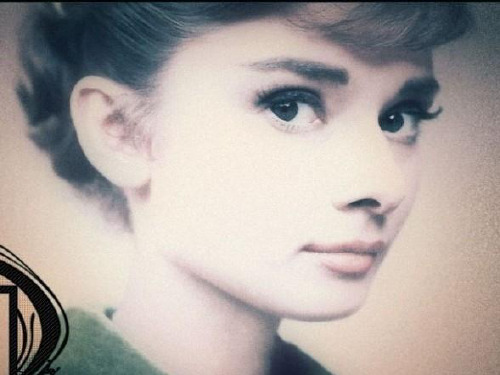
• For attractive lips, speak words of kindness. • 魅力的双唇,在于亲切友善的语言。
• For lovely eyes, seek out the good in people. • 想要可爱的眼睛,善于探寻别人的优点。
• For a slim figure, share your food with the hungry. • 得到苗条的身影,请与饥饿的人分享你的 食物。
At first,she was signed to a bit part in a European film in ter,she took the role of princess Annie in Roman Holiday in 1953
This film turned out to be a great success and she won an Oscar as Bburn
A great soul
Audrey Hepburn was born on May 4th, 1929 in Brussels, Belgium.She really was blue-blood (贵族 血统)from the beginning with her father, a wealthy English banker, and her mother, a Dutch baroness. (荷兰女男 爵)
My Fair Lady 窈窕淑女
Robin and Marian 罗宾和玛丽安
Always
《直到永远》
Remember, if you ever need a helping hand, it is at the end of your arm. As you get older, you must remember that you have a second hand. The first one is to help yourself, the second one is to help other. ---Audrey Hepburn
奥黛丽赫本英文简介

The world revere her as an angel on earth
Though we've never seen God, we meet an angel indeed. She is Audrey Hepburn.
Thanks for your attention ! ! !
begin taking ballet lessons put all her effort into ballet training
be a model
Audrey gained immediate prominence in the US with her role in Roman Holiday in 1953
Hollywood’s all-time favourite actress Audrey Hepburn 奥黛丽· 赫本
Audrey Hepburn 奥黛丽· 赫本
Hollywood 好莱坞
Belgium 比利时 Audrey Hepburn was born on May 4, 1929 in Brussels, Belgium.
ቤተ መጻሕፍቲ ባይዱ
a great beauty, a great actress and a great humanitarian
The beauty of a woman is not in a facial mode but the true beauty in a woman is reflected in her soul. It is the caring that she lovingly gives the passion that she shows. The beauty of a woman grows with the passing years. 女人的魅力不在于外表, 真正美丽的折射于一个女 人灵魂深处,在于亲切的 给予和热情。一个女人的 美丽随着岁月而增长。
奥黛丽赫本经典英文简介
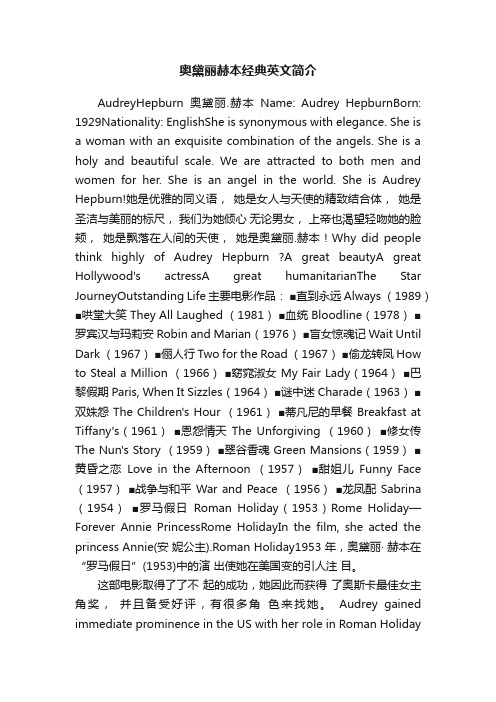
奥黛丽赫本经典英文简介AudreyHepburn奥黛丽.赫本Name: Audrey HepburnBorn: 1929Nationality: EnglishShe is synonymous with elegance. She is a woman with an exquisite combination of the angels. She is a holy and beautiful scale. We are attracted to both men and women for her. She is an angel in the world. She is Audrey Hepburn!她是优雅的同义语,她是女人与天使的精致结合体,她是圣洁与美丽的标尺,我们为她倾心无论男女,上帝也渴望轻吻她的脸颊,她是飘落在人间的天使,她是奥黛丽.赫本!Why did people think highly of Audrey Hepburn ?A great beautyA great Hollywood's actressA great humanitarianThe Star JourneyOutstanding Life主要电影作品:■直到永远 Always (1989)■哄堂大笑 They All Laughed (1981)■血统 Bloodline(1978)■罗宾汉与玛莉安 Robin and Marian(1976)■盲女惊魂记 Wait Until Dark (1967)■俪人行 Two for the Road (1967)■偷龙转凤 How to Steal a Million (1966)■窈窕淑女 My Fair Lady(1964)■巴黎假期 Paris, When It Sizzles(1964)■谜中迷 Charade(1963)■双姝怨 The Children's Hour (1961)■蒂凡尼的早餐 Breakfast at Tiffany's(1961)■恩怨情天The Unforgiving (1960)■修女传The Nun's Story (1959)■翠谷香魂 Green Mansions(1959)■黄昏之恋Love in the Afternoon (1957)■甜姐儿Funny Face (1957)■战争与和平 War and Peace (1956)■龙凤配 Sabrina (1954)■罗马假日Roman Holiday(1953)Rome Holiday—Forever Annie PrincessRome HolidayIn the film, she acted the princess Annie(安妮公主).Roman Holiday1953 年,奥黛丽· 赫本在“罗马假日”(1953)中的演出使她在美国变的引人注目。
奥黛丽赫本 中英文简介
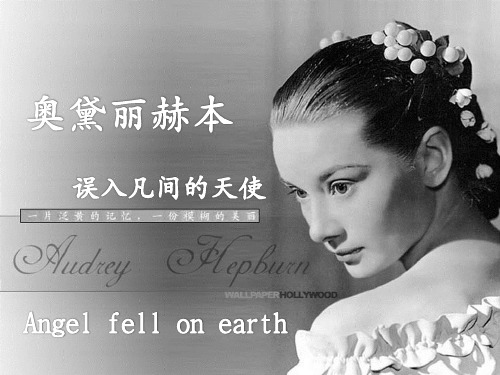
赫本一生中共获得五次奥斯卡最佳女主 角提名。2002年5月,联合国儿童基金会在 其纽约总部为一尊7英尺高的青铜雕像揭幕, 雕 像 名 字 为 奥 黛 丽 精 神 ( The Spirit of Audrey ),以表彰赫本为联合国所做的贡 献。
Goodbye Angel
The princess in roman holiday insisted to cut off her beautiful hair ,this small change in reality affected the whole word,now let’s look at Hepburn’s hair .
1988年,奥黛丽· 赫本成 为联合国儿童基金会特使, 对拉丁美洲和非洲的儿童给 予帮助,一直做到1993年。
1993年1月20日,奥黛丽·赫本 因结肠癌死于瑞士的洛桑,享年63岁。 Audrey Hepburn died on January 20, 1993 in Switzerland,from colon cancer
奥黛丽永远比她的影片更具 魅力,更经得起时间的考验。
Audrey Hepburn is more charming than her film ,and it’s herself which can withstand the test of time more th是联合国儿童基 金会亲善大使的代表人 物,为第三世界妇女与 孩童争取权益。1992年 被授予美国“总统自由 勋章”,1993年获奥斯 卡人道主义奖。
她被人物杂志评为 世界上最美丽的50 人之一
She was named to People’s magazine
as one of the 50 best beautiful people in the world.
奥黛丽赫本的生平英语作文
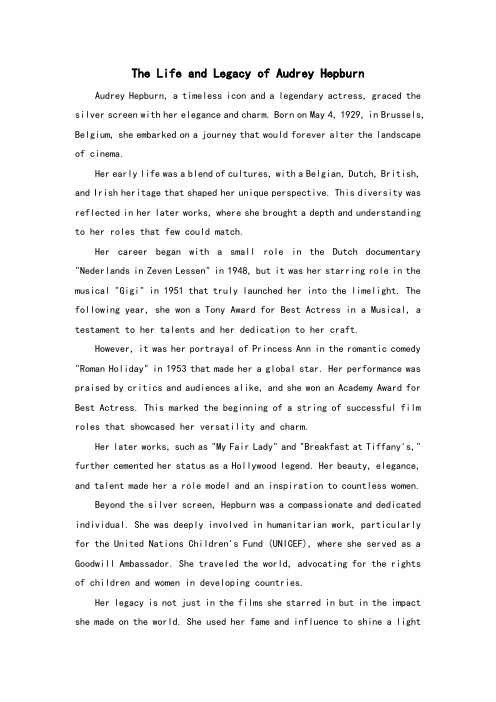
The Life and Legacy of Audrey Hepburn Audrey Hepburn, a timeless icon and a legendary actress, graced the silver screen with her elegance and charm. Born on May 4, 1929, in Brussels, Belgium, she embarked on a journey that would forever alter the landscape of cinema.Her early life was a blend of cultures, with a Belgian, Dutch, British, and Irish heritage that shaped her unique perspective. This diversity was reflected in her later works, where she brought a depth and understanding to her roles that few could match.Her career began with a small role in the Dutch documentary "Nederlands in Zeven Lessen" in 1948, but it was her starring role in the musical "Gigi" in 1951 that truly launched her into the limelight. The following year, she won a Tony Award for Best Actress in a Musical, a testament to her talents and her dedication to her craft.However, it was her portrayal of Princess Ann in the romantic comedy "Roman Holiday" in 1953 that made her a global star. Her performance was praised by critics and audiences alike, and she won an Academy Award for Best Actress. This marked the beginning of a string of successful film roles that showcased her versatility and charm.Her later works, such as "My Fair Lady" and "Breakfast at Tiffany's," further cemented her status as a Hollywood legend. Her beauty, elegance, and talent made her a role model and an inspiration to countless women.Beyond the silver screen, Hepburn was a compassionate and dedicated individual. She was deeply involved in humanitarian work, particularly for the United Nations Children's Fund (UNICEF), where she served as a Goodwill Ambassador. She traveled the world, advocating for the rights of children and women in developing countries.Her legacy is not just in the films she starred in but in the impact she made on the world. She used her fame and influence to shine a lighton issues that mattered, and her dedication to humanitarian work left a lasting impression on countless lives.Audrey Hepburn passed away on January 20, 1993, but her memory and her works continue to inspire and captivate audiences. She remains a timeless icon, a symbol of elegance, charm, and compassion, whose life and legacy will forever be remembered.。
奥黛丽赫本英语简介
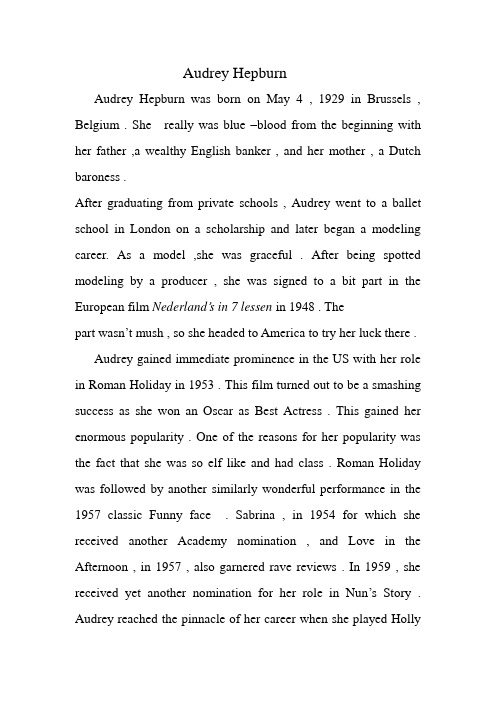
Audrey HepburnAudrey Hepburn was born on May 4 , 1929 in Brussels , Belgium . She really was blue –blood from the beginning with her father ,a wealthy English banker , and her mother , a Dutch baroness .After graduating from private schools , Audrey went to a ballet school in London on a scholarship and later began a modeling career. As a model ,she was graceful . After being spotted modeling by a producer , she was signed to a bit part in the European film Nederland’s in 7 lessen in 1948 . Thepart wasn’t mush , so she headed to America to try her luck there .Audrey gained immediate prominence in the US with her role in Roman Holiday in 1953 . This film turned out to be a smashing success as she won an Oscar as Best Actress . This gained her enormous popularity . One of the reasons for her popularity was the fact that she was so elf like and had class . Roman Holiday was followed by another similarly wonderful performance in the 1957 classic Funny face . Sabrina , in 1954 for which she received another Academy nomination , and Love in the Afternoon , in 1957 , also garnered rave reviews . In 1959 , she received yet another nomination for her role in Nun’s Story . Audrey reached the pinnacle of her career when she played HollyGolightly in the delightful film , Breakfast at Tiffany’s in 1961 . For this she received another nomination . One of Audrey’s most radiant roles was in the fine production of My Fair Lady , in 1964 .By the end of the sixties , after her divorce from actor Mel Ferrer , Audrey decided to retire while she was on top . Later she married Dr.Andrea Dotti . From time to time , she would appear on the silver screen . In 1988,Audrey became a special ambassador to the United Nations UNICEF fund helping children in Latin America and Africa , a position she retained until 1993 . She was named to People’s magazine as one of the 50 most beautiful people in the world . Her last film was Always in 1989 . Audrey Hepburn died on January 20 , 1993 in Tolochnaz , Switzerland , from colon cancer . She had made a total of 31 high quality movies . Her elegance and style will always be remembered in film history as evidenced by her being named to Empire magazine’s “The Top 100 Movie Stars of All Time ” .。
Audrey Hepburn-奥黛丽.赫本英文简介

Times magazine said, “Audrey fits none of the cliches and none ofere is a bronze statue—— The Spirit of Audrey to souvenir HB.
War & Peace
Tiffany’s
罗马假日(Roman Holiday)1953 罗马假日(Roman 战争与和平 (War and Peace)1956 修女传 (The Nun's Story)1959 窈窕淑女 (My Fair Lady)1964 第凡内早餐 (Breakfast at Tiffany's ) 1961
MASTERPIECES MASTERPIECES MASTERPIECES MASTERPIECES MASTERPIECES MASTERPIECES MASTERPIECES MASTERPIECES
19511953 1956 1961 1964
My Fair Lady
Roman Holiday Breakfast at Gigi
Work for UNICEF
Soon after Hepburn's final film role, she was appointed goodwill ambassador to the United Nations Children's Fund. Fund. Grateful for her own good fortune after enduring the German occupation as a child, she dedicated the remainder of her life to helping impoverished children in the poorest nations.
赫本生平英文作文
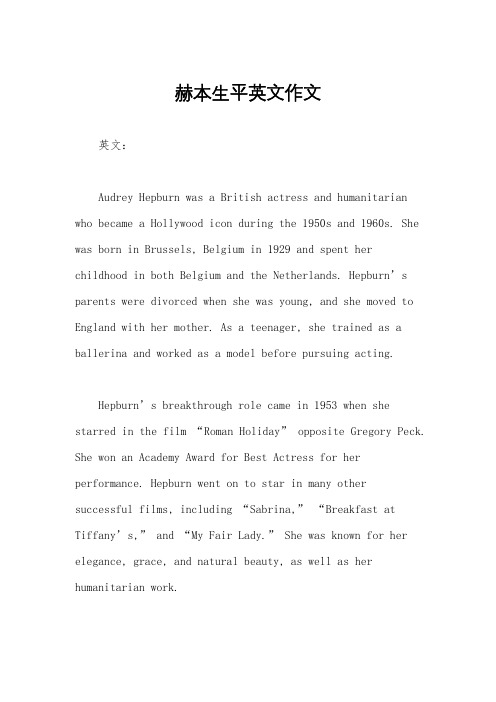
赫本生平英文作文英文:Audrey Hepburn was a British actress and humanitarian who became a Hollywood icon during the 1950s and 1960s. She was born in Brussels, Belgium in 1929 and spent her childhood in both Belgium and the Netherlands. Hepburn’s parents were divorced when she was young, and she moved to England with her mother. As a teenager, she trained as a ballerina and worked as a model before pursuing acting.Hepburn’s breakthrough role came in 1953 when she starred in the film “Roman Holiday” opposite Gregory Peck. She won an Academy Award for Best Actress for her performance. Hepburn went on to star in many other successful films, including “Sabrina,” “Breakfast at Tiffany’s,” and “My Fair Lady.” She was known for her elegance, grace, and natural beauty, as well as her humanitarian work.Hepburn was a UNICEF Goodwill Ambassador and worked tirelessly to help children in need around the world. She traveled to many countries, including Ethiopia, Somalia, and Vietnam, to raise awareness and funds for UNICEF. Hepburn was also a supporter of animal rights and environmental causes.Despite her success and fame, Hepburn remained humble and down-to-earth. She once said, “Success is like reaching an important birthday and finding you’re exactly the same.” Hepburn’s l egacy continues to inspire people around the world to this day.中文:奥黛丽·赫本是一位英国女演员和人道主义者,于20世纪50年代和60年代成为好莱坞的偶像。
奥黛丽赫本的个人英语作文
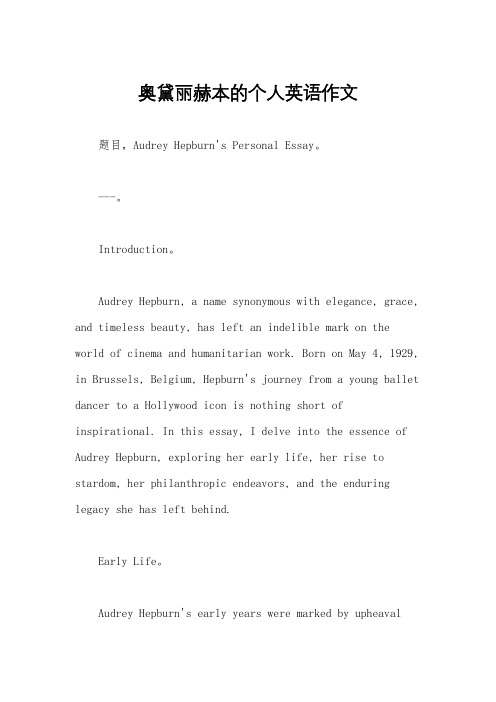
奥黛丽赫本的个人英语作文题目,Audrey Hepburn's Personal Essay。
---。
Introduction。
Audrey Hepburn, a name synonymous with elegance, grace, and timeless beauty, has left an indelible mark on the world of cinema and humanitarian work. Born on May 4, 1929, in Brussels, Belgium, Hepburn's journey from a young ballet dancer to a Hollywood icon is nothing short of inspirational. In this essay, I delve into the essence of Audrey Hepburn, exploring her early life, her rise to stardom, her philanthropic endeavors, and the enduring legacy she has left behind.Early Life。
Audrey Hepburn's early years were marked by upheavaland challenges. Born to a British father, Joseph Hepburn-Ruston, and a Dutch mother, Ella van Heemstra, Audrey experienced the hardships of World War II firsthand. Her family struggled during the Nazi occupation of the Netherlands, and Audrey witnessed the horrors of war at a tender age.Despite the adversity she faced, Audrey's passion for dance and performance remained undimmed. She trained as a ballet dancer in Arnhem and later in London, harboring dreams of becoming a prima ballerina. However, fate had other plans for her, leading her down a path that would ultimately catapult her to international fame.Rise to Stardom。
audery hepburn(奥黛丽赫本介绍)

By the end of the sixties, after her divorce from actor Mel Ferrer, Audrey decided to retire while she was on top. Later she married Dr. Andrea Dotti. From time to time, she would appear on the silver screen. One film of note was Robin and Marian (1976) with Sean Connery in 1976. In 1988, Audrey became a special ambassador to the United Nations UNICEF fund helping children in Latin America and Africa, a position she retained until 1993. She was named to People's magazine as one of the 50 most beautiful people in the world. Her last film was Always (1989) in 1989.
Audrey Hepburn died on January 20, 1993 in Tolochnaz, Switzerland, from colon cancer. She had made a total of 31 high quality movies. Her elegance and style will always be remembered in film history as evidenced by her being named to Empire magazine's "The Top 100 Movie Stars of All Time".
介绍Audrey Hepburn的英语演讲稿

Look at these photos, can you recognize who she is? I think it is so easy, she is an excellent film star ---Audrey Hepburn.In my mind, Audrey Hepburn was the most nearly perfect female.Though she has been far from us for almost 20 years,but I believe many people just like me will remember her beauty,her kindness and her remarkable achievements forever.Audrey Hepburn’s nationality is Britain,but she was born in Blibune Blusail. She was died of colon cancer when 63 years old. During her lifetime, she had married twice and had two children.As a outstanding film star, Hepburn had received lots of awards,such as Academy Award, Golden Globe Award and so on.We all know that Hepburn had played a great many films in her life. She is one of Hollywood's most famous actresses,In 1999,she was elected to be the great actress in hundred years by American film instituteToday,I’ll introduce you three of HB’s films: Roman holiday and My Fair Lady.We know, Roman holiday was considered to be HB’s representative works,it tells a story that a European princess and an American journalist met in Rome, Italy,and within one day,they occurred a romantic story.These are some stage photos in the film.many of us must have seen this classical movie.To tell the truth,I started to like HB after watching this movie.Her innocent, kind and smile impressed me so much.And after Roman holiday won the Oscar,plenty of praises were put forward,including our familiar poet---Xi Murong. 。
- 1、下载文档前请自行甄别文档内容的完整性,平台不提供额外的编辑、内容补充、找答案等附加服务。
- 2、"仅部分预览"的文档,不可在线预览部分如存在完整性等问题,可反馈申请退款(可完整预览的文档不适用该条件!)。
- 3、如文档侵犯您的权益,请联系客服反馈,我们会尽快为您处理(人工客服工作时间:9:00-18:30)。
Audrey Hepburn1990–1992[edit]In October 1990, Hepburn went to Vietnam in an effort to collaborate with the government for national UNICEF-supported immunisation and clean water programmes.In September 1992, four months before she died, Hepburn went to Somalia. Calling it "apocalyptic", she said, "I walked into a nightmare. I have seen famine in Ethiopia and Bangladesh, but I have seen nothing like this – so much worse than I could possibly have imagined. I wasn't prepared for this."[citation needed] "The earth is red – an extraordinary sight –that deep terracotta red. And you see the villages, displacement camps and compounds, and the earth is all rippled around these places like an ocean bed and I was told these were the graves. There are graves everywhere. Along the road, wherever there is a road, around the paths that you take, along the riverbeds, near every camp – there are graves everywhere."[80]Though scarred by what she had seen, Hepburn still had hope. "Taking care of children has nothing to do with politics. I think perhaps with time, instead of there being a politicisationof humanitarian aid, there will be a humanisation of politics." "Anyone who doesn't believe in miracles is not a realist. I have seen the miracle of water which UNICEF has helped to make a reality. Where for centuries young girls and women had to walk for miles to get water, now they have clean drinking water near their homes. Water is life, and clean water now means health for the children of this village." "People in these places don't know Audrey Hepburn, but they recognise the name UNICEF. When they see UNICEF their faces light up, because they know that something is happening. In the Sudan, for example, they call a water pump UNICEF."Hepburn and Gregory Peck bonded during the filming of Roman Holiday (1953) and there were rumours that they were romantically involved; both denied it. Hepburn, however, added, "Actually, you have to be a little bit in love with your leading man and vice versa. If you're going to portray love, you have to feel it. You can't do it any other way. But you don't carry it beyond the set."[85] They did however become lifelong friends. During the filming of Sabrina (1954), Hepburn and the already-married William Holden became romantically involved. She hoped to marry him and have children, but she broke off the relationship when Holden revealed that he had undergone a vasectomy.[86][87] Although a common perception that Bogart and Hepburn (both starred in Sabrina together) did not get along, Hepburn commented that, "Sometimes it's the so-called 'tough guys' that are the most tender hearted, as Bogey was with me."[88]Hepburn and Andrea DottiAt a cocktail party hosted by Gregory Peck, Hepburn met American actor Mel Ferrer.[48] Ferrer recalled that, "We began talking about theatre; she knew all about the La Jolla Playhouse Summer Theatre, where Greg Peck and I had been co-producing plays. She also said she'd seen me three times in the movie Lili. Finally, she said she'd like to do a play with me, and she asked me to send her a likely play if I found one."[48][89] Ferrer, vying for Hepburn to take the title role, sent her the script for the play Ondine. She agreed and rehearsals started in January 1954. Eight months later, on 25 September 1954, after meeting, working together, and falling in love, the pair were married in Bürgenstock[90] while preparing to star together in the film War and Peace (1955).Before having their only son, Hepburn had two miscarriages -- one in March 1955[91] and another in 1959. The latter occurred when filming The Unforgiven (1960) where breaking her back after falling off a horse and onto a rock resulted in hospital stay and miscarriage induced by physical and mental stress. Hepburn took a year off work in order to carry a child to term. Sean Hepburn Ferrer, their son, whose godfather was the novelist A. J. Cronin, who resided near Hepburn in Lucerne, was born on 17 July 1960.Despite the insistence from gossip columns that their marriage would not last, Hepburn claimed that she and Ferrer were inseparable and happy together, though she admitted that he had a bad temper.[92] Ferrer was rumored to be too controlling of Hepburn and had been referred to by others as being her "Svengali" – an accusation that Hepburn laughedoff.[93] William Holden was quoted as saying, "I think Audrey allows Mel to think he influences her." Hepburn had another two miscarriages later, in 1965 and 1967.[94] After a 14-year marriage, the couple divorced on December 5, 1968. Their son believed that Hepburn had stayed in the marriage too long. In June 2008, Mel Ferrer died of heart failure at the age of 90."[Givenchy] gave me a look, a kind, a silhouette. He has always been the best and he stayed the best. Because he kept the spare style that I love. What is more beautiful than a simple sheath made an extraordinary way in a special fabric, and just two earrings?" revealed Hepburn.[117] Givenchy created her outfits for many other films, including Funny Face, Love in the Afternoon, Breakfast at Tiffany's, Paris When It Sizzles, Charade and How to Steal a Million (in which at one point her character is disguised as a cleaning woman and the male lead, played by Peter O'Toole, remarks that this "gives Givenchy a night off"). The designer was always amazed that, even after thirty five years of collaboration, "her measurements [had] not changed an inch."[117] Givenchy remained Hepburn's friend and ambassador, and she his muse, throughout her life. Hepburn observed, "I have many things in common with Hubert. We like the same things."[117] She agreed to model, on occasions, the creations of her friend. In 1988, when he presented his summer collection in Paris, she said, "Wherever I am in the world, he is always there. He is a man who does not disperse into worldliness. He has time for those he loves."[117] Givenchy subsequently created a perfume for her titled L'Interdit (French for "Forbidden").She equally inspired fashion photographer Richard Avedon, who captured an intentionally overexposed close-up of Hepburn's face in which only her famous features – her eyes, her eyebrows, and her mouth – are visible. "I am, and forever will be, devastated by the gift of Audrey Hepburn before my camera. I cannot lift her to greater heights. She is already there. I can only record. I cannot interpret her. There is no going further than who she is. She has achieved in herself her ultimate portrait."[118] One of her many costars, Shirley Maclaine, wrote in her 1996 memoir My Lucky Stars, "[Hepburn] had very rare qualities and I envied her style and taste. I felt clumsy and old fashioned when I was with her." Hepburn's fashion styles continue to be popular among women today.[119]Hepburn in Breakfast at Tiffany's(1961)Italian shoe designer Salvatore Ferragamo created a shoe for her and made her ambassador of his fashion house while honouring her in a 1999 exhibition dedicated to the actress titled Audrey Hepburn, a woman, the style. She exercised fashion in her lifetime and continues to influence fashion. Fashion experts affirmed that Hepburn's longevity as a style icon results from her sticking with a look that suited her: "clean lines, simple yet bold accessories, minimalist palette."[120]Although Hepburn enjoyed fashion, she did not place much importance on it, preferring casual and comfortable clothes contrary to her image.[121] In addition, she never considered herself attractive. She stated in a 1959 interview, "you can even say that I hated myself at certain periods. I was too fat, or maybe too tall, or maybe just plain too ugly... you can say my definiteness stems from underlying feelings of insecurity and inferiority. I couldn't conquer。
